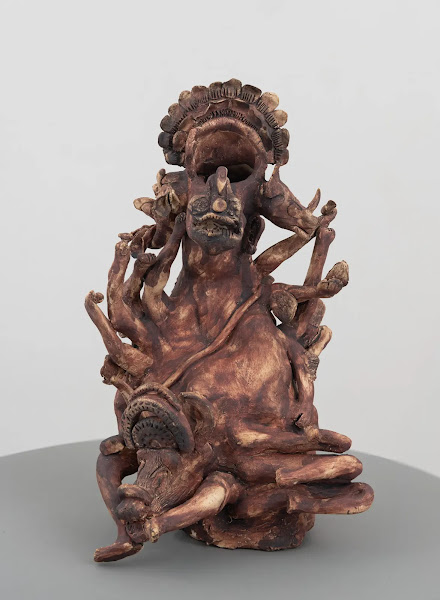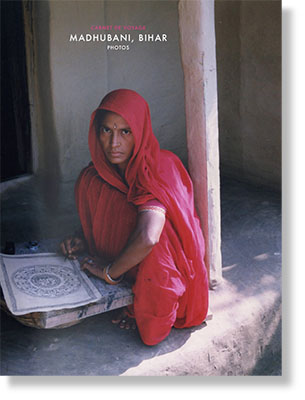mercredi 25 janvier 2023
In memoriam: Balkrishna V Doshi (1927 – 2023)
A glance at the dates and it's clear that Balkrishna V Doshi and modern Indian architecture grew side by side. A student at the JJ School of Art in Mumbai when India celebrated its independence in 1947, the architect's career runs alongside the creation of some of the country's most iconic contemporary architecture. From his involvement in the Chandigarh project and India's famous Le Corbusier and Louis Kahn heritage, through to its finest architecture education institution – he designed and founded the School of Architecture and Planning in Ahmedabad in 1962 – Dr Balkrishna Vithaldas Doshi has been an omnipresent figure for a remarkable period of India's built environment.
> read more
Institution-Building in the Global South: Roobina Karode of the Kiran Nadar Museum of Art in New Delhi
Source Art in America by Mira Dayal
When the Kiran Nadar Museum opened in 2010, we had a three-pronged approach: build a collection, build a museum, and build an audience. We didn’t have a real museum space yet, but we still had to create the museum, so we worked hard on forming an audience base and expanding the collection. At that time, there were just over 200 works in the collection; we’ve now crossed the 10,000 mark. That includes photographs, drawings, prints, and installations dating from the 1950s onward. Not having a specifically designed building had its positive side, because we were not confined to the museum; we organized exhibitions in Chandigarh, Jaipur, Kerala. I often draw concentric circles: We are located here, but we have to move from the museum to the city, from this city to another city, then to the nation and outside the country. But finally, we were able to find land for a building that Adjaye Associates is now designing. It will be an art and culture center with eight galleries as well as auditoriums, ideation rooms, a library, and a restaurant. We will be able to bring out a lot of the collection, rotated annually.
> read more
vendredi 13 janvier 2023
Mumbai's commercial art scene undergoes major 'post-pandemic' expansion
In what is being presented as a sure sign of India's flourishing art market, Mumbai Gallery Weekend (MGW) is currently holding its largest edition yet (until 15 January), with 32 participants—its first regular event since 2020. Since then, the financial capital's gallery landscape has seen significant shifts as India's leading dealers have rolled out expansion and relocation plans in the city. The first such instance was in March 2022, when Mumbai's oldest contemporary art gallery Chemould Prescott Road launched an extension programme supporting young and emerging artists. Chemould CoLab, named in part for its location in the southern gallery hub neighbourhood of Colaba, is co-directed by Sunaina Rajan and Atyaan Jungalwala, the daughter of Chemould Prescott Road's owner Shireen Gandhy.
> read more
8 must-see shows at the ongoing Mumbai Gallery Weekend 2023
Whatever your thoughts on Maximum City's cultural life, the Mumbai Gallery Weekend 2023 (MGW) is here to enliven it. More than 30 leading galleries have banded together this year for exhibitions and special events including pop-up shows and dance performances sprawled across different sites around the city (though still in close proximity to each other). This ongoing four-day extravaganza (on until 15 January) offers a tantalizing window into Mumbai's art scene where creative conversation, above all else, connects enthusiasts, students, artists, collectors and gallerists with members of the public. Art is for everyone and MGW, currently in its 11th year, embodies that utilitarian philosophy, giving visitors a platform to engage in a thoughtful dialogue with history, politics, culture, craftsmanship and global trends in visual arts. As Mortimer Chatterjee, director, Chatterjee & Lal gallery, puts it: "This is a time when all the galleries come together as a community and celebrate modern and contemporary art. It's like a festival."
> read more
mercredi 4 janvier 2023
Here's what to expect from the India Art Fair 2023
As we continue to stay true to our mission of bringing the best of modern and cutting-edge contemporary art from India and South Asia, all in one place, in this edition we pool together our collective learnings from the last few years. Making space for traditional art forms of South Asia, the fair facade will be transformed into a “Forest of the Future” by a talented Warli artist duo, the Vayeda Brothers, who bring a contemporary outlook to the ancient art form from Maharashtra. Our other Artists in Residence — Debashish Paul and Lakshmi Madhavan — will present exciting projects. While Paul will unfold his queer identity in a performance art piece, Madhavan’s community-driven art practice will shine through in her installation of bright white-and-gold kasavu textiles made in collaboration with the fast-disappearing community of weavers of Balarampuram in Kerala. I am particularly excited about some of our art projects. My favourites include Parag Tandel’s thought-provoking sculptural installation in which he recreates the seven small islands that made up Mumbai before it grew into a mega metropolis; a surreal eight-foot-tall, twisted fibreglass scale by Shivani Agarwal inviting audiences to measure the intangible, such as emotions of love, joy, intimacy, and truth; and a monumental sculpture resembling a pelvic bone by Prashant Pandey, which references the marvellous moment of the birth of life — all of which will be spread across the warm winter outdoors of the fair.
> read more
lundi 2 janvier 2023
Meet the Vayeda Brothers—artists and storytellers taking the beauty of Warli to the world
"Warli is not just an art form; we are a people,” assert the young artist and sibling duo Mayur and Tushar Vayeda who are here to prove a point. Hailing from the village of Ganjad in rural Maharashtra, the duo—better known as the Vayeda Brothers—have been passionately chronicling their memories and observations of community life in their art. “We want to act as a bridge between the ancient and modern worlds by translating the wisdom and knowledge passed down from our ancestors into a language that can be understood by all,” explain the duo who see themselves as not just artists but also researchers, storykeepers, and educators. Today, the Vayeda Brothers firmly believe: “Warli is our responsibility.” They are infusing a new dynamism by showcasing at international exhibitions and residencies, creating ambitious illustrated book projects and marking their presence in monumental murals all over the world—including a larger-thanlife seascape that was unveiled at Sassoon Docks for the Mumbai Urban Arts Festival in December 2022 and the facade of India Art Fair in New Delhi, which will be transformed into a “Forest of the Future” in February 2023. With all this and more, the Vayeda Brothers are rising to the occasion by breaking the boundaries between folk and contemporary art.
> read more
dimanche 1 janvier 2023
Meet the greatest modernists of the Indian folk art
There is no one story of Indian folk art. Be it the canvas-filling geometric shapes of ancient Warli art from Maharashtra, the dizzying dashes and dots of Gond and Bhil art from central India, or the playful yet precise paintings of Madhubani and Kalighat art from the east, each form has its own deep history and vocabulary, despite the many interactions and interconnections. In the last century, industrial paper has replaced mud walls and floors as the main canvas, and the sacred philosophies behind many of the folk traditions have become absorbed into the grand narrative of the country’s race to modernize. Many of the self-taught artists, outsiders to urban art markets, have been compelled to take to daily-wage labour. However, a few have stood the test of time — sometimes by chance and sometimes through sheer will—radically opposing reigning ideas of industrial progress and art market trends, and inspiring younger generations of artists today. Here, we celebrate the greatest modernists of Indian folk art.
> read more
Archives revue de presse
-
▼
2023
(66)
-
▼
janvier
(7)
- In memoriam: Balkrishna V Doshi (1927 – 2023)
- Institution-Building in the Global South: Roobina ...
- Mumbai's commercial art scene undergoes major 'pos...
- 8 must-see shows at the ongoing Mumbai Gallery Wee...
- Here's what to expect from the India Art Fair 2023
- Meet the Vayeda Brothers—artists and storytellers ...
- Meet the greatest modernists of the Indian folk art
-
▼
janvier
(7)

























